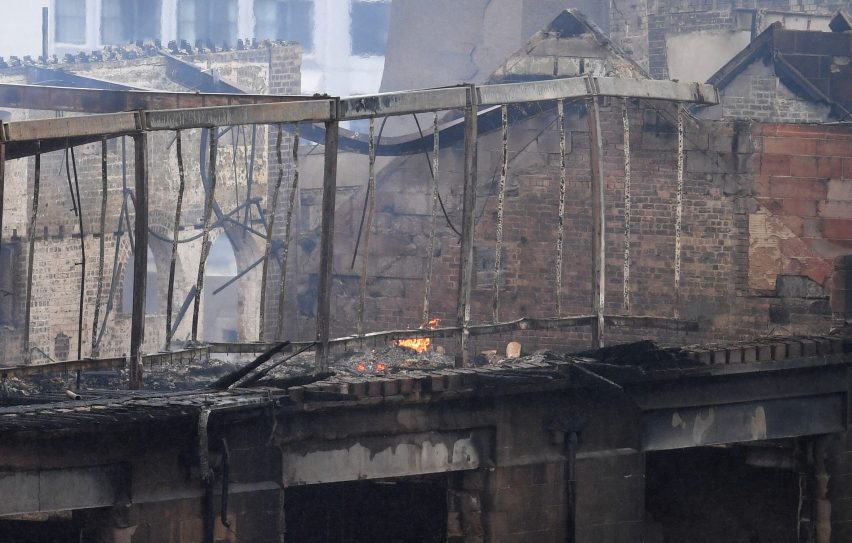Glasgow School of Art must be rebuilt, argues Mark Cousins, not just because it's Charles Rennie Mackintosh's masterpiece, but because it's an invaluable showcase for Scottish craft skills.
The role of the architect is often overly romanticised in popular culture. Think Liam Neeson in Love Actually or Gary Cooper's portrayal of Howard Roark in The Fountainhead. Roark exemplifies the myth of the visionary architect struggling to assert his genius, battling the apparently philistine attitudes of colleagues and clients. The drama culminates with Roark dynamiting his own building, rather than accepting a compromised design.
Glasgow-born Charles Rennie Mackintosh was equally uncompromising. He single-handedly forged a bold new architecture, stripped of overbearing Victorian embellishments and ostentatious accumulation. Recognised as a pioneer of modernism, he remains Scotland's most celebrated architect, despite having built remarkably few buildings.
Glasgow School of Art (GSA) was his masterpiece. But on 23 May 2014, it was ravaged by fire. The resultant media coverage revealed enormous support for the building and attracted fundraising endorsements from luminaries such as Brad Pitt and Peter Capaldi.
It also sparked a huge debate on the rights and wrongs of new-build versus conservation versus preservation versus restoration. There followed a year of impassioned deliberation, including two international symposia – one in Glasgow and one at the Rem Koolhaas-curated Venice Architecture Biennale. These addressed the challenges of adapting a Category A listed building and rendering it fit for purpose as a working school of art.
Talk of wholesale demolition is a distraction
At the conclusion of these deliberations, Glasgow School of Art director Tom Inns announced that the building would be restored to its original state, with the library replicated "as closely as possible to Mackintosh's design", and local practice Page\Park was appointed to oversee the project.
There was widespread shock at the news of a second, even more destructive, fire. Artist Margaret Archbold spoke for many when she observed that the GSA" should have been the safest building in Glasgow" but "just keeps getting kicked in the teeth".
This time around, the fire decimated the entire building. And yet, talk of wholesale demolition is a distraction.
Glasgow School of Art carries with it an immense historical burden. It simply cannot be razed. Nicola Sturgeon, first minister of Scotland, needs to demonstrate that she is serious about protecting the nation's heritage and Mackintosh's legacy.
The school is not only integral to the nation's self-image but also imbedded within a wider international discourse. Liberal historians and social commentators may speculate on notions of national identity, but the GSA needs to be seen as symbolic architecture, which effectively transcends petty concerns such as budgetary constraints. The project affords Scotland immeasurable kudos and this disaster represents an opportunity to reflect on a broader philosophical narrative.
The project affords Scotland immeasurable kudos and this disaster represents an opportunity to reflect on a broader philosophical narrative
This fire, coupled with the recent demise of plans to rehabilitate St Peter's Seminary in Cardross, has raised big concerns about how we safeguard Scotland's limited canon of 20th-century architectural icons.
Former alumni and artist Alison Watt was right when she described the GSA as a "powerful symbol of creativity in the city", as "an idea, as much as a building".
It's paramount that the GSA is rebuilt as a showcase for Scottish craft skills and a testament to Mackintosh's influential role in the development of contemporary design culture.
Investigations have begun into the cause of the blaze. Presumably the project manager will have undertaken a comprehensive fire strategy plan prior to commencing work on site, but everyone is demanding answers urgently. Yes, everything has changed, but essentially, nothing has changed.
Yes, the damage needs to be assessed, budgets reviewed and programmes revised, but this tragic setback should not alter the agreed strategy. We may only be able to retain the facade but Page\Park are talented architects and can comprehensively incorporate salvages elements within a nuanced proposition.
The building must not be relegated to mere museum status but remain a functioning art college
The building must not be relegated to mere museum status but remain a functioning art college. We should look again at Norman Foster's approach at the Reichstag in Berlin, where the Russian soldiers' graffiti was conserved, and the Castelvecchio Museum in Verona, by Venetian-born architect Carlo Scarpa.
Scarpa was acknowledged as a consummate continuer of history and this extended commission afforded him the opportunity to tease apart the building's rich history and tell its story. Scarpa's own contemporary architectural intervention became a significant new layer and has garnered international acclaim arguably because of its adherence to William Morris' belief in preservation, not restoration.
Breaking news suggests that Hollywood's Zack Snyder is adapting Ayn Rand's The Fountainhead. Her book champions reckless individualism, and has been cited lately as a bible for the Make America Great Again generation, but Rand's so-called philosophy is intellectually vapid and many fear that this new cinematic version will be another senseless remake of a classic film.
We cannot let Mackintosh's masterpiece succumb to such an ignominious fate.
Photograph is by Jeff J Mitchell.

